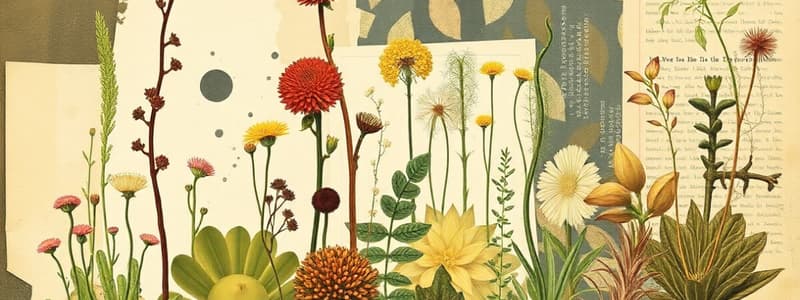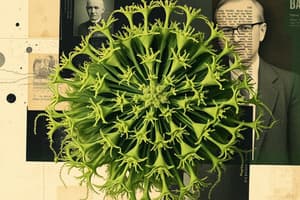Podcast
Questions and Answers
Approximately how many years ago did land plants originate?
Approximately how many years ago did land plants originate?
- 420 million
- 475 million (correct)
- 500 million
- 305 million
Which of these characteristics is associated with bryophytes?
Which of these characteristics is associated with bryophytes?
- Thick, complex leaves
- Large size
- Small size (correct)
- Waxy cuticle
What is the dominant life cycle stage of bryophytes?
What is the dominant life cycle stage of bryophytes?
- Seed-bearing
- Vascular
- Gametophyte (correct)
- Sporophyte
What is required for sperm to move to the female gametophyte in bryophytes?
What is required for sperm to move to the female gametophyte in bryophytes?
What is the primary means by which bryophytes absorb water and CO2?
What is the primary means by which bryophytes absorb water and CO2?
What adaptation do vascular plants have that bryophytes lack?
What adaptation do vascular plants have that bryophytes lack?
What does the term 'thallus' refer to in the context of bryophytes?
What does the term 'thallus' refer to in the context of bryophytes?
Which of these plant groups does NOT belong to the bryophytes?
Which of these plant groups does NOT belong to the bryophytes?
What is the dominant stage in the life cycle of vascular plants?
What is the dominant stage in the life cycle of vascular plants?
What is the function of xylem in vascular plants?
What is the function of xylem in vascular plants?
Which of these is a characteristic of seedless vascular plants?
Which of these is a characteristic of seedless vascular plants?
Which of these groups include ferns and horsetails?
Which of these groups include ferns and horsetails?
What term describes the coiled leaves of ferns that uncoil during development?
What term describes the coiled leaves of ferns that uncoil during development?
What is the dominant life cycle stage in Pterophytes?
What is the dominant life cycle stage in Pterophytes?
What is a key innovation of seed plants compared to seedless plants?
What is a key innovation of seed plants compared to seedless plants?
What is the function of pollen in seed plants?
What is the function of pollen in seed plants?
Which of the following structures surrounds the embryo in seed plants?
Which of the following structures surrounds the embryo in seed plants?
Which phyla are seed plants represented by?
Which phyla are seed plants represented by?
Which of these describes gymnosperm seeds?
Which of these describes gymnosperm seeds?
Which group dominates in northern latitudes?
Which group dominates in northern latitudes?
Which of the following is a distinct group of extant gymnosperms?
Which of the following is a distinct group of extant gymnosperms?
Which of these is the only living species of its group?
Which of these is the only living species of its group?
What adaptation is seen in conifers that allows them to thrive in cold, dry conditions?
What adaptation is seen in conifers that allows them to thrive in cold, dry conditions?
What characteristics do Gnetophytes have that are similar to Angiosperms?
What characteristics do Gnetophytes have that are similar to Angiosperms?
What is a key characteristic that distinguishes angiosperms from gymnosperms?
What is a key characteristic that distinguishes angiosperms from gymnosperms?
What is the estimated percentage of angiosperms among all plant species?
What is the estimated percentage of angiosperms among all plant species?
What advantage did early angiosperms gain from the use of insect pollinators?
What advantage did early angiosperms gain from the use of insect pollinators?
Which plants are included in Magnoliids?
Which plants are included in Magnoliids?
What is a common food crop example of a monocot?
What is a common food crop example of a monocot?
What is a feature of eudicots?
What is a feature of eudicots?
Which of these is considered an economically important plant that is grouped as a monocot?
Which of these is considered an economically important plant that is grouped as a monocot?
Which plant group has about 75% of angiosperms?
Which plant group has about 75% of angiosperms?
What adaptation is NOT associated with mosses?
What adaptation is NOT associated with mosses?
Which adaptation allows vascular plants to grow larger than nonvascular plants?
Which adaptation allows vascular plants to grow larger than nonvascular plants?
Which gymnosperm group is characterized by large cones and palm-like leaves?
Which gymnosperm group is characterized by large cones and palm-like leaves?
Flashcards
First Plant Lineage
First Plant Lineage
The first plant lineage to diverge after plants moved onto land, characterized by unique life cycles.
Bryophytes
Bryophytes
Small, simple, and tough plants that lack a vascular system, including mosses, liverworts, and hornworts.
Thallus
Thallus
Flattened photosynthetic structures which characterize bryophytes.
Bryophyte Life Cycle
Bryophyte Life Cycle
Signup and view all the flashcards
Bryophytes and Moist Environments
Bryophytes and Moist Environments
Signup and view all the flashcards
Waxy Cuticle
Waxy Cuticle
Signup and view all the flashcards
Peat Bogs
Peat Bogs
Signup and view all the flashcards
Vascular Plants
Vascular Plants
Signup and view all the flashcards
Sporophyte Dominance
Sporophyte Dominance
Signup and view all the flashcards
Xylem
Xylem
Signup and view all the flashcards
Phloem
Phloem
Signup and view all the flashcards
Seedless Vascular Plants
Seedless Vascular Plants
Signup and view all the flashcards
Lycophytes
Lycophytes
Signup and view all the flashcards
Pterophytes
Pterophytes
Signup and view all the flashcards
Sporophyte-dominated life cycle
Sporophyte-dominated life cycle
Signup and view all the flashcards
Fronds
Fronds
Signup and view all the flashcards
Seeds
Seeds
Signup and view all the flashcards
Seed innovations
Seed innovations
Signup and view all the flashcards
Pollen
Pollen
Signup and view all the flashcards
Gymnosperms
Gymnosperms
Signup and view all the flashcards
Cycads
Cycads
Signup and view all the flashcards
Ginkgos
Ginkgos
Signup and view all the flashcards
Conifers
Conifers
Signup and view all the flashcards
Conifers Adaptations
Conifers Adaptations
Signup and view all the flashcards
Gnetophytes
Gnetophytes
Signup and view all the flashcards
Angiosperms
Angiosperms
Signup and view all the flashcards
Protected Seeds
Protected Seeds
Signup and view all the flashcards
Angiosperm Key Features
Angiosperm Key Features
Signup and view all the flashcards
Angiosperm Groups
Angiosperm Groups
Signup and view all the flashcards
Magnoliids
Magnoliids
Signup and view all the flashcards
Monocots
Monocots
Signup and view all the flashcards
Eudicots
Eudicots
Signup and view all the flashcards
Plant Life cycle Summary
Plant Life cycle Summary
Signup and view all the flashcards
Study Notes
Phylogenetic Relationships & Plant Diversity
- Lecture focuses on phylogenetic relationships and plant diversity
Plant Origins and Evolution
- Land plants originated approximately 475 million years ago (mya).
- Vascular plants evolved around 420 mya.
- Extant seed plants emerged about 305 mya.
Nonvascular Plants (Bryophytes)
- Represented by mosses, liverworts, and hornworts.
- Bryophytes were the first plant lineage to diverge after plants moved onto land.
- They have a small, simple, and tough structure.
- Bryophytes are small due to constraints of fertilization, requiring water for sperm to reach the female gametophyte.
- Typically have flattened photosynthetic structures known as a thallus, only a few cells thick and lack internal air spaces or vascular systems.
- Haploid gametophyte dominates the life cycle, supporting the non-photosynthetic sporophyte.
- Water and CO2 are absorbed through plant surfaces via diffusion.
- They do not possess a waxy cuticle, reducing water loss.
- Bryophytes require a moist environment but can tolerate desiccation.
- They are poor competitors for light and space.
- Peat bogs (Sphagnum) are an exception and play a key ecological role by creating acidic, wet conditions that slow decomposition and store large amounts of organic carbon.
- Peat bogs are found in boreal forests.
- Bryophytes are vulnerable to climate change.
Seedless Vascular Plants
- Differ from nonvascular plants (bryophytes) for a sporophyte dominated diploid lifecycle.
- They possess vascular tissue, xylem for water transport and phloem for sugar transport.
- Seedless vascular plants are less dependent on water for reproduction.
- Represented by lycophytes and ferns/horsetails (pterophytes).
- Pterophytes are a monophyletic group.
- Most ferns have coiled leaves that uncoil during growth.
- Fronds are the distinctive leaves, divided into smaller units called pinnae.
- Stems grow underground and can spread easily.
- Vascular tissue enables plants to grow larger but size is limited by the lack of secondary vascular tissue.
- Sporophyte dominates the life cycle, protecting the small photosynthetic gametophyte.
Seed Plants
- The development of seeds enabled plants to become the dominant producers on land.
- Do not require external water for fertilization.
- Consist of an embryo and nutrients (endosperm) surrounded by a protective coat.
- Pollen facilitates dispersal of male gametes via wind or animals, eliminating the need for water.
Gymnosperms
- Divided into four distinct groups: Cycads, Ginkgos, Conifers, and Gnetophytes.
- Characterized by "naked" seeds not enclosed by ovaries.
- Gymnosperms are better adapted than nonvascular plants to drier conditions.
Gymnosperm Groups
- Cycads: Individuals have large cones and palm-like leaves and can live in nutrient-poor conditions with insect pollination. Most species are tropical and are on endangered species lists.
- Ginkgos: There is only one living species (Ginkgo biloba), which can tolerate air pollution and is a popular ornamental tree with health benefits.
- Conifers: Most conifers are evergreens that carry out photosynthesis all year and tolerate cold, dry conditions. Conifers include Douglas Fir, Wollemi Pine and Sequoia.
- Conifers can dominate angiosperms in cold/dry climates subject to freeze-thaw cycles.
- Tallest Tree is the Coast Redwood (Sequoia Sempervirens) which is 115.7 meters tall.
- Oldest Tree is the Bristlecone Pine (Pinus Longaeva) which is 5064 years old.
- Three key features of the gymnosperm life cycle: The dominance of the sporophyte generation, the development of seeds from fertilized ovules, and transfer to sperm to ovules by pollen (wind transport).
- Conifers can dominate angiosperms in cold/dry climates subject to freeze-thaw cycles.
- Gnetophytes: Comprised of 3 genera with varying appearances and live in either tropical or desert environments with features similar to angiosperms and use double fertilization.
- Vary in Appearance and consist of (1) Multicellular Xylem Vessels (2) Double Fertilization.
Angiosperms
- Exhibit "protected" seeds enclosed by ovaries.
- Angiosperms consist of six groups.
- Best suited to life on land and are the most widespread diverse group of plants, with diversity possibly attributable to slower rates of species loss than species formation.
- The earliest angiosperms are evolved in the understory of dominating gymnosperm forests,
- Utilize insect pollination, which gave them an advantage in areas where there was limited wind because of this limited species loss and a slower rate of species formation.
Angiosperm Groups
- Amborella, Water Lilies, & Star Anise are the three rarer groups to evolve first.
- Magnoliids include magnolias, laurels, black pepper, and avocados. Common in early angiosperm evolution in tropical areas.
- Monocots comprise about 25% of angiosperms and include food crops such as rice, wheat, corn, sugar cane, bananas, ginger, and pineapple and include economically important plants such as bamboo, orchids, lilies, daffodils, and tulips.
- Eudicots: comprise about 75% of angiosperms, include both economically important and interesting plants, such as carnivorous, parasitic, and epiphytes.
Studying That Suits You
Use AI to generate personalized quizzes and flashcards to suit your learning preferences.




